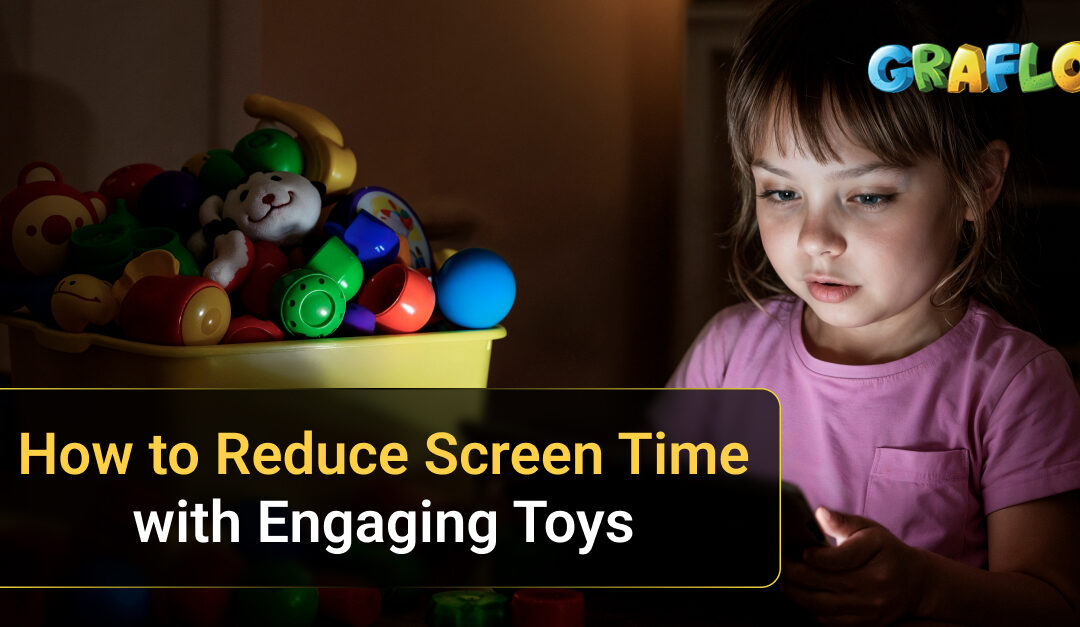In today’s digital world, screens are everywhere; televisions, tablets, smartphones, and computers have become an inseparable part of children’s daily lives. While technology offers incredible learning opportunities, excessive screen time can affect a child’s physical health, creativity, and social skills. As parents, finding ways to reduce screen time kids spend online has become more important than ever.
One of the most effective and fun ways to achieve this balance is through engaging, hands-on toys that inspire active play, imagination, and learning. In this guide, we’ll explore why reducing screen time matters, how engaging toys can help, and which types of play experiences best capture children’s attention away from devices.
The Growing Concern About Screen Time
Research consistently shows that children spend an average of 5–7 hours per day in front of screens. Whether for school, entertainment, or gaming, this prolonged exposure can lead to several challenges, including eye strain, sleep disruption, attention difficulties, and even mood issues.
Parents often struggle to find a healthy balance. Limiting screens abruptly can lead to frustration or boredom, but replacing them with meaningful alternatives can make the transition smoother and more enjoyable. That’s where interactive, creative toys come into play.
To reduce screen time for kids, it’s crucial to understand that the goal isn’t to ban technology altogether but to replace some digital activities with equally stimulating, real-world experiences that keep them engaged and happy.
Why Engaging Toys Are the Perfect Solution
Toys have always been powerful tools for learning and development. But in an era where screens dominate, engaging toys offer something different; they provide real interaction, encourage creativity, and promote active thinking.
These toys challenge children to use their hands and minds simultaneously, helping them develop problem-solving skills, patience, and focus. Unlike screens, which provide instant gratification, toys require imagination and persistence, qualities essential for lifelong learning.
Whether it’s building a tower with blocks, solving a puzzle, or creating art, such activities offer a tangible sense of accomplishment that screens simply can’t match. That’s why they’re the ideal tool to reduce daily screen experience.
The Hidden Benefits of Play Without Screens
When children play with physical toys instead of screens, they engage multiple senses, touch, sight, and movement, which support overall development. Here are some key benefits:
- Improved Motor Skills: Activities like stacking, building, or drawing strengthen hand-eye coordination.
- Better Social Interaction: Group play encourages sharing, teamwork, and empathy.
- Enhanced Creativity: Open-ended toys like LEGO, art kits, and pretend play sets allow kids to express themselves freely.
- Healthier Sleep Patterns: Reducing screen exposure before bedtime promotes better rest.
- Boosted Focus: Physical play helps children build attention spans that screens often shorten.
Every time parents encourage real play, they take a small but important step toward reduce screen time spent passively consuming content.
Choosing the Right Toys to Capture Attention
The secret to successfully reduce screen time lies in choosing the right toys, ones that truly captivate your child’s interest. Kids need stimulation, and the right toys can provide endless opportunities for exploration and creativity.
When choosing toys, consider the following factors:
- Age Appropriateness: Select toys suitable for your child’s developmental stage to keep them challenged but not frustrated.
- Open-Ended Design: Toys that can be used in multiple ways (like building blocks, clay, or art supplies) spark imagination and longer playtime.
- Educational Value: STEM toys, puzzles, and construction kits make learning fun and practical.
- Physical Activity: Toys that involve movement, such as jump ropes, scooters, or balance boards, help kids stay active while having fun.
For example, at Graflo Toys, you can find a range of creative, educational, and motor-skill-building toys that are designed to keep children deeply engaged without screens.
Fun Toy Categories That Encourage Active Play
Let’s explore a few toy types that can effectively help reduce screen time and promote a balanced, active lifestyle:
1. Building and Construction Toys
LEGO sets, magnetic tiles, and building blocks stimulate problem-solving and creativity. Children can construct endless designs, fostering patience and logical thinking.
2. Outdoor Toys
Scooters, jump ropes, or mini sports kits get kids moving. Outdoor play enhances coordination, fitness, and appreciation for nature.
3. Arts and Crafts Sets
Art encourages self-expression. Paint sets, clay kits, or DIY craft boxes let children explore color, texture, and imagination without needing a screen.
4. STEM and Educational Toys
STEM-based kits combine fun with learning. From simple robotics to science experiments, these toys inspire curiosity and cognitive growth.
5. Pretend Play and Role-Playing Toys
Kitchen sets, doctor kits, or dollhouses help kids imitate real-life scenarios. Such imaginative play builds social understanding and empathy.
Each of these toy types can transform how children spend their free time, making it easy to reduce screen time naturally, without arguments or resistance.
Creating a Balanced Routine
Introducing toys alone won’t magically solve screen dependency; it’s about creating a balanced routine that integrates play, study, rest, and digital time. Here’s how to build that balance:
- Set Clear Screen Time Limits: Create boundaries that children understand and follow.
- Encourage Play Sessions: Dedicate certain times of the day to play with physical toys.
- Play Together: Join in! Shared play strengthens bonds and sets a positive example.
- Reward Creativity: Praise children when they choose toys over screens.
- Keep Toys Accessible: Display engaging toys in open spaces to remind kids of their presence.
When families make playtime a shared priority, it becomes much easier to reduce screen time kids experience daily.
How Parents Can Lead by Example
Children often model the behavior they see. If parents spend a lot of time on their phones or laptops, kids naturally assume that’s normal. Limiting your own screen time sends a powerful message.
Try setting “device-free zones” at home, such as during meals or before bedtime. Use that time for interactive play, storytelling, or board games. When parents actively participate, children are more likely to follow along and enjoy non-digital activities.
Encouraging these habits gradually helps reduce screen time in a natural, positive way rather than through strict restrictions.
The Role of Social and Group Play
Another excellent strategy to keep children engaged is promoting social play. Kids love to play together; it gives them a sense of connection and joy. Organize playdates, family game nights, or group activities where children can share toys and ideas.
Board games, building challenges, or outdoor races help children collaborate, learn teamwork, and build communication skills, all while minimizing digital distractions. Social play has the added benefit of emotional development, making it a powerful tool to reduce the screen time kids spend alone on devices.
Integrating Learning Through Play
Educational toys can make learning exciting and interactive. When kids associate fun with learning, they naturally prefer hands-on play over passive screen time.
For example, puzzle sets improve memory, logic, and attention to detail. Math or word games strengthen academic skills, while science kits encourage exploration. These toys keep children curious and intellectually active, making it easier to reduce the screen time kids spend on non-educational content.
Transforming Playtime Into Family Time
Playing together as a family creates lasting memories. It strengthens relationships and builds communication between parents and children. Whether it’s solving puzzles, building models, or playing with toy cars, shared activities nurture trust and connection.
When children see play as something enjoyable to do with family, they’ll naturally drift away from screens. Family play is one of the most rewarding ways to reduce kids’ screen time while adding laughter and bonding to daily life.
Tips to Keep Kids Engaged Without Screens
To ensure children stay interested in toys, keep things fresh and exciting:
- Rotate Toys: Introduce new toys occasionally and store older ones for a while; when you bring them back, they’ll feel brand new.
- Create Themed Play Areas: Design spaces for art, construction, or pretend play.
- Mix Active and Quiet Play: Balance energy-burning toys with creative or educational sets.
- Let Kids Choose: Give children some control over what they play with, and they’ll stay more engaged.
These strategies can make playtime appealing, helping parents successfully reduce the screen time kids experience each day.
Summary and Conclusion
Balancing technology with meaningful play is one of the biggest parenting challenges of our time. However, by introducing engaging, hands-on toys, parents can help children rediscover the joy of creativity and imagination.
The key to successfully reducing the screen time kids spend online lies in offering enriching alternatives: fun, educational, and physically active toys that nurture body and mind.
Every hour away from the screen is an hour spent learning, laughing, and growing. With the right toys and parental involvement, you can help your child find real-world adventures that no screen can match.






